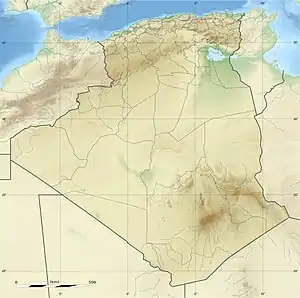1954 Chlef earthquake
The 1954 Chlef earthquake struck Chlef Province in French Algeria on September 9 at 02:04:43 local time. The shock measured 6.7 on the moment magnitude scale and had a maximum Mercalli intensity of XI (Extreme). It destroyed Chlef, then named Orléansville, leaving over 1,243 people dead and 5,000 injured. Damage was estimated at $6 million. It was followed by multiple aftershocks. Algeria faces annual earthquakes and has undergone several changes to its earthquake building codes since its first earthquake engineering regulations from 1717.
 Algiers Oran | |
| UTC time | 1954-09-09 01:04:43 |
|---|---|
| ISC event | 891046 |
| USGS-ANSS | ComCat |
| Local date | September 9, 1954 |
| Local time | 02:04:43 |
| Magnitude | 6.7 Mw[1] |
| Depth | 15 km (9.3 mi)[1] |
| Epicenter | 36.27°N 1.59°E[1] |
| Type | Dip-slip[2] |
| Areas affected | Chlef Province French Algeria |
| Total damage | $6 million [3] |
| Max. intensity | XI (Extreme) [3] |
| Tsunami | 0.33 m (1 ft 1 in) [4] |
| Casualties | 1,243–1,409 dead [4] 5,000 injured[4] |
Geology
Powerful earthquakes strike Algeria annually, ranging in Mercalli intensity scale intensity from VI (Strong) to XI (Extreme).[5] Chlef was hit by another major earthquake in 1980 which killed 3,500 people.[6] The Atlas Mountains area faces aseismic deformation (change in shape not originating from movement of faults), with only marginal plate shifting each year.[6] Both Chlef earthquakes originated from the same reverse fault zone.[2]
The 1954 earthquake measured 6.7 on the moment magnitude scale according to the International Seismological Centre and had a depth of 15 km (9.3 mi). There is evidence of crustal shortening along a NW-SE trend near the epicenter, but the structure of any faults is poorly understood.[7] Because Algeria has a thin shelf and a steep coastal slope, submarine landslides are quite common, especially during earthquakes.[8] During the 1954 earthquake, five underwater telephone cables in the Mediterranean Sea[9] were cut by an avalanche, three recording the exact time of impact.[8]
Damage and casualties
Shaking extended west to Mostaganem, south to Tiaret, and east to Tizi Ouzou, and many aftershocks followed the earthquake, including a major tremor at 22:18 UTC on September 16 which further damaged Orleansville.[9] The main shock ruptured 16 km (9.9 mi) of rock, ripping faults and creating visible fissures in the ground along the Dahra Massif. Survivors described a sensation of rotating along an axis and that the rubble reminded them of "bombed cities in Europe."[10] The United States Geological Survey lists the 1954 quake among the deadliest earthquakes in history.[11] Agence France-Presse (AFP) reported that it was the worst earthquake in North African history.[10]
Aftermath
The French army on the spot largely participated in the relief and triggered the first airlift aeromedical evacuation in Africa. Bell 47G helicopters, three Amiot AAC.1 Toucan and two Douglas DC-3 evacuated 396 victims, including 147 on the first day, avoiding any traffic jams on site.[12]
Orléansville was devastated by the earthquake; a fifth of it wholly destroyed,[13] it was rebuilt and renamed El Asnam and later Chlef.[9] While Algeria had set earthquake resistance regulations as early as 1717, it was the 1954 earthquake that ushered in fully comprehensive reforms for seismic-resistant design.[5]
References
- ISC (2015), ISC-GEM Global Instrumental Earthquake Catalogue (1900–2009), Version 2.0, International Seismological Centre
- Dewey, James W. (1991), "The 1954 and 1980 Algerian earthquakes: Implications for the characteristic-displacement model of fault behavior", Bulletin of the Seismological Society of America, 81 (2): 446
- National Geophysical Data Center / World Data Service (NGDC/WDS) (1972), Significant Earthquake Database (Data Set), National Geophysical Data Center, NOAA, doi:10.7289/V5TD9V7K
- USGS (September 4, 2009), PAGER-CAT Earthquake Catalog, Version 2008_06.1, United States Geological Survey
- Paz, Mario, ed. (1994). International Handbook of Earthquake Engineering: Codes, Programs, and Examples. Springer. p. 57. ISBN 978-0412982118.
- Ambraseys, N.N. (1981). "The El Asnam (Algeria) earthquake of 10 October 1980; conclusions drawn from a field study". Quarterly Journal of Engineering Geology. Geological Society of London. 14 (2): 143–148. doi:10.1144/GSL.QJEG.1981.014.02.05. S2CID 140701882. Retrieved September 6, 2013.
- El-Robrini, Gennesseaux, and Mauffret, pg 171.
- El-Robrini, Gennesseaux, and Mauffret, pgs 171–2.
- "Earthquakes with 1,000 or More Deaths Since 1900". United States Geological Survey. November 30, 2012. Archived from the original on January 14, 2013. Retrieved September 6, 2013.
- "1954:Algerian Earthquake: In Our Pages: 100, 75 And 50 Years Ago". The New York Times. September 10, 2004.
- "Today in Earthquake History: September 9". United States Geological Survey. October 2, 2012. Retrieved September 6, 2013.
- Ollivier et Monjauze, « Le service de santé de l’Air en Algérie », Regards sur la France, no 7 « Le service de santé des armées en Algérie 1830-1958, numéro spécial », octobre-novembre 1958, p. 257-264.
- "800 Feared Dead In Algeria Quake; Tremor Rocks 50-Mile Area, Catching People Asleep". The New York Times. September 10, 1954. Retrieved September 6, 2013.
Sources
- El-Robrini, M.; Gennesseaux, M.; Mauffret, A. (1985). "Consequences of the El-Asnam earthquakes: Turbidity currents and slumps on the Algerian margin (Western Mediterranean)". Geo-Marine Letters. 5 (3): 171–176. Bibcode:1985GML.....5..171E. doi:10.1007/BF02281635. S2CID 129874657.
External links
- The International Seismological Centre has a bibliography and/or authoritative data for this event.